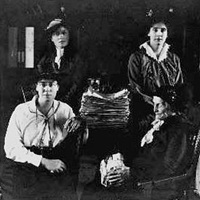

by Maurice Y. Michaud (he/him)

 GetArchive.net — Public domain
GetArchive.net — Public domainIn an August 2024 article in Psychology Today, Stanley Cohen restated a long-known finding that we tend to assume that a dog that is unknown to us is male. Similarly, there’s a stereotypical idea “that engineers and mathematicians are always male, while nurses and elementary school teachers are all female.” We can safely add politicians to the list of males.
Stanley Cohen restated a long-known finding that we tend to assume that a dog that is unknown to us is male. Similarly, there’s a stereotypical idea “that engineers and mathematicians are always male, while nurses and elementary school teachers are all female.” We can safely add politicians to the list of males.
The numbers explain it all. Of the 71,995 distinct persons recorded in PoliCan:
The picture is bleaker when we look at the number of elected individuals.
Looking at that second set of numbers, one could be tempted to think that, when a party believes it has little chance of winning a riding, it lets a woman stand.
| Women’s right to vote and to be a candidate | |||||
|---|---|---|---|---|---|
| Right ↓ |
 CA |
← Federal
Provinces + Territories
↓ |
|||
| Vote | 1918 | ||||
| Candidate | 1919 | ||||
 BC |
 AB |
 SK |
 MB |
 ON |
|
| Vote | 1917 | 1916 | 1916 | 1916 | 1917 |
| Candidate | 1917 | 1916 | 1916 | 1916 | 1919 |
 QC |
 NB |
 NS |
 PE |
 NL |
|
| Vote | 1940 | 1919 | 1918 | 1922 | 1925 |
| Candidate | 1940 | 1934 | 1918 | 1922 | 1925 |
 YT |
 NT |
 NU |
Exclusions (men or women) ↳ Asians until 1948
↳ Inuit until 1951
↳ First Nations until 1960
| ||
| Vote | 1919 | 1951 | 1999 | ||
| Candidate | 1919 | 1951 | 1999 | ||
When Canadian women 21 years or older woke up on New Year’s Day 1920, most of them had the right to vote and to run as candidates. Those in Prince Edward Island had to wait two more years, while those in Québec had to wait another 20 years. For their part, New Brunswick women had a 15-year gap between obtaining the right to vote and the right to run as candidates. In Newfoundland, which wasn’t part of Canada yet, women 25 years old or greater were enfranchised in 1925.
The territories did not have responsible government in 1919. In fact, the federal government ran the territories entirely from Ottawa. So when saying that women in the Yukon obtained the right to vote in 1919, it was only at the federal level until a partial responsible government was established in 1970. Also, when saying that women in Nunavut got the vote in 1999, that refers to the year that the territory was created from the eastern portion of the Northwest Territories, where women had obtained the right to vote as soon as a form of responsible government was established there in 1951.
It must be noted that, regardless of gender, most First Nations people did not have the right to vote until 1960, nor did “Orientals” — meaning people of Chinese or Japanese descent — until 1948. The Inuit gained the right to vote with the establishment of the territorial responsible government in 1951, but the eastern part of the territory was not represented in Parliament until the 1962 general election.
All that being said, it is nonetheless remarkable that, after a century, so few women have been successful at being elected. However, the search engines in this subsection help you uncover the fact that women only started running in considerable numbers in the middle of the 1970s.
In this subsection looking specifically at women in elections held in Canada, you can find:
You might also be interested in these articles in the People section:
It wouldn’t hurt them, but it wouldn’t necessarily help them, either.
While some political parties today insist on nominating as many men as women, the numbers that can be gleaned out of this section of PoliCan suggest that politics in Canada and Québec largely remains a “boys’ club.” When parties put forward what they consider their “star candidates,” more often than not they are men — the current prime minister being a prime example, with no disrespect to Mr. Carney.
There is already a suspicion than women, consciously or not, are often made to be the sacrificial lambs. If we were to move to a mixed-member proportional system with closed lists, who’s to say that this bias wouldn’t persist? It will depend largely on how much each party holds equitable gender representation as important, and finding ways of using the new system to reach that objective.